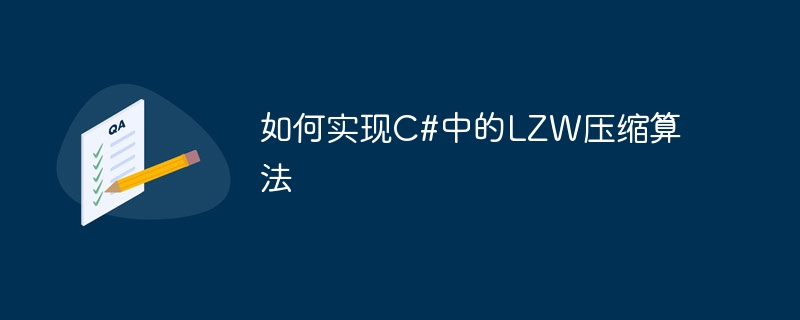
如何實現C#中的LZW壓縮演算法
引言:
隨著資料的不斷增長,資料的儲存和傳輸成為了一項重要任務。 LZW(Lempel-Ziv-Welch)壓縮演算法是一種常用的無損壓縮演算法,可以有效地減少資料的體積。本文將介紹如何在C#中實作LZW壓縮演算法,並給出具體的程式碼範例。
using System;
using System.Collections.Generic;
using System.Text;
class LZWCompression
{
public static List<int> Compress(string data)
{
Dictionary<string, int> dictionary = new Dictionary<string, int>();
List<int> compressedData = new List<int>();
int currentCode = 256;
for (int i = 0; i < 256; i++)
{
dictionary.Add(((char)i).ToString(), i);
}
string currentString = "";
foreach (char c in data)
{
string newString = currentString + c;
if (dictionary.ContainsKey(newString))
{
currentString = newString;
}
else
{
compressedData.Add(dictionary[currentString]);
dictionary.Add(newString, currentCode);
currentCode++;
currentString = c.ToString();
}
}
if (currentString != "")
{
compressedData.Add(dictionary[currentString]);
}
return compressedData;
}
public static string Decompress(List<int> compressedData)
{
Dictionary<int, string> dictionary = new Dictionary<int, string>();
StringBuilder decompressedData = new StringBuilder();
int currentCode = 256;
for (int i = 0; i < 256; i++)
{
dictionary.Add(i, ((char)i).ToString());
}
int previousCode = compressedData[0].Value.ToString();
decompressedData.Append(dictionary[previousCode]);
for (int i = 1; i < compressedData.Count; i++)
{
int currentCode = compressedData[i];
if (dictionary.ContainsKey(currentCode))
{
decompressedData.Append(dictionary[currentCode]);
string newEntry = dictionary[previousCode] + dictionary[currentCode][0];
dictionary.Add(currentCode, newEntry);
previousCode = currentCode;
}
else
{
string newEntry = dictionary[previousCode] + dictionary[previousCode][0];
decompressedData.Append(newEntry);
dictionary.Add(currentCode, newEntry);
previousCode = currentCode;
}
}
return decompressedData.ToString();
}
}
下面是LZW壓縮演算法的使用範例:
using System;
using System.Collections.Generic;
class Program
{
static void Main(string[] args)
{
string originalData = "AAAAABBBBCCCCCDDDDDEE";
Console.WriteLine("原始数据: " + originalData);
List<int> compressedData = LZWCompression.Compress(originalData);
Console.WriteLine("压缩后的数据: " + string.Join(",", compressedData));
string decompressedData = LZWCompression.Decompress(compressedData);
Console.WriteLine("解压缩后的数据: " + decompressedData);
Console.ReadLine();
}
}以上程式碼範例中,我們使用LZWCompression類別進行了資料的壓縮與解壓縮,其中壓縮使用了Compress方法,解壓縮使用了Decompress方法。
結論:
本文介紹如何在C#中實作LZW壓縮演算法,並給出了具體的程式碼範例。 LZW壓縮演算法是一種常用且有效的無損壓縮演算法,可以幫助我們減少資料的體積,提高資料的儲存和傳輸效率。
以上是如何實作C#中的LZW壓縮演算法的詳細內容。更多資訊請關注PHP中文網其他相關文章!




